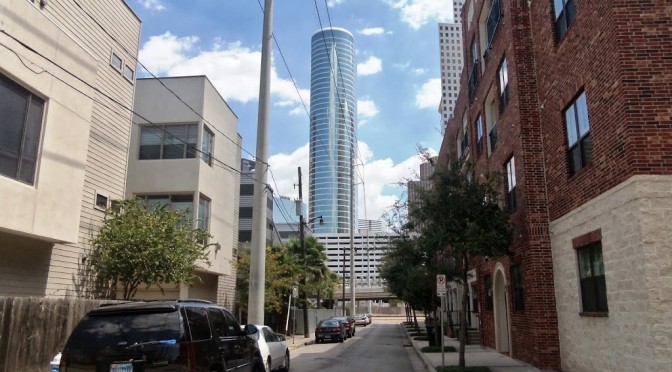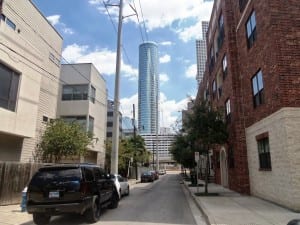If you’ve been to Houston recently (and took some time to exit the freeways), you probably could tell one thing pretty quickly… the city is in the throws of a rapid transformation. Much of this building boom is taking place in the form of new condominiums and mid-rise structures, which will likely increase after revisions to the city’s development code. But it’s not just the law that is mandating these types of developments… much of it is driven market demand, as more and more Houstonians prefer to live in a traditional “built urban” environment.
The shift in thinking is starting to get noticed outside the city as well, for it affects the way Houston does business. Take this interesting interview on the changing face of Houston architecture, from an architect’s perspective. The editor of the Chicago Architecture Blog interviewed John Lahey, CEO of Simon Cordwell Buenz. SCB is a Chicago-based firm that is currently working on projects across the United States, including two in Houston.
Editor: Houston is a whole different market.
Lahey: For an urban person, it’s not as accommodating. But there is a sprit of Texas that you can’t help but like. Even if, politically or whatever, you’re not in sync with it, their do-it-yourself identity is really kind of neat.
Editor: How is working in Texas different than the other markets you’re working in?
Lahey: The people that we’re working for in Texas are from Texas, so the Texas imprint is very apparent. I would say in Texas it’s just not as dense and hard an urban environment, and it’s a little more gracious. A little more landscaping when you come into the building. It’s hot, but it’s sunny a lot. The units are a little bigger.
There’s a vitality in Texas that is different. Chicago and San Francisco have very established urban areas and you’re sort of being part of an established urban framework. Whereas in Texas, you can be more freewheeling, and people want to just celebrate it a little more. The buildings in Chicago have a lot of civility, where in Texas… it’s hard to say exactly what’s different.
In Texas the construction costs aren’t as much as they are here, and so you get more for your money.
Editor: And no zoning in Houston.
Lahey: Austin has zoning. It has a lot of zoning. But the buildings there are large, and we’re working on a few smaller ones, too.
Editor: In the last few years, people in Houston seem to be coming around to the notion that it’s OK to live in a tower instead of a rambler.
Lahey: I think there’s quite a bit of it. And then there’s more stuff starting to happen in downtown. The one that we’re doing in Montrose isn’t a super-tall tower. It’s probably half as tall as this [Rincon Two], but that’s tall for there. But what’s neat about an area like that where there’s already a density and there’s restaurants and stuff, when you bring in that many people and do it in a way that still lets the neighborhood be what it is, it’s just more people going to these things. Walking to them. And you can see how the urban experience that we all love, will morph into a Texas way of being urban.
Austin is a little more urban feeling because of all the music downtown, and it’s pretty centralized. And because of the size of Austin, they’ve probably got a denser core than Houston. But I think Houston is going to be really good. The things that are happening there are really positive.
Editor: Are there things that you have to do differently designing a building in Houston?
Lahey: It’s not so cold, so when you do your amenities, the outdoor — the pools and all that stuff — are really important because you’re going to be using that a lot.
Balconies… You know, it gets so hot that some people want them and some people don’t. Somebody told me that you just don’t sit out a lot in Houston. So when we’re doing it, there is the thought that people are going to be in their apartments and have the windows closed and have the air conditioning on a lot.
Now in Chicago, we have the same thing in the winter — people are going to be inside and have the heat on. So, they’re similar. Whereas in Chicago, you’re making sure things don’t get too dark, in Houston you’re making sure things don’t get too light. You don’t have the short days, what you have is the big hot sun. Here you’ve got the winter, when it’s dark and it’s cloudy, and you want to make sure you get enough light into each unit.
Editor: Do you need heavier HVAC units and bigger ducts for all that air conditioning in Houston?
Lahey: A lot of it is done with natural ventilation, although we do use mechanical ventilation a lot more in Texas than we would here. Here it’s mostly natural ventilation because people can just open a window. In Houston, you want fresh air, but you’re just not going to touch that window.
The old traditional building with the punched openings and small windows, we hardly [ever do that]. We like the more modern, contemporary ones with the views. When you live in a high-rise that’s the one great amenity that you have, and when you see the views being limited by the size of windows, that seems wrong.
The aesthetic of buildings, people there really do respond to more contemporary buildings today. They like having big amounts of glass in their living rooms. Bedrooms aren’t so critical. But that’s happening across the board. It’s everywhere.
That’s in Hawaii, that’s in California, that’s in Texas, that’s in Chicago, and it’s in Miami. It’s everywhere.
As Mr. Lahey says, there are definitely some advantages to the having a more “fluid urban environment” like you find in Houston. One project, like Discovery Green, can spur a whole burst of new activity virtually on its own. It’s great to see so many developers noticing the changes in trends, and looking for copious business opportunities in the city. As a Houstonian, there’s nothing more exciting than getting to witness the growth and change happening throughout the city. But it also serves as a reminder that along with the new wave of development, Houston cannot leave its basic infrastructure behind. Just as important to the renaissance of the city’s built urban environment and densification is the full commitment of the city to improve our ailing drainage and sewer systems so they can keep up with the dizzying growth. A complete streets initiative becomes all the more imperative as our city gains more residents, and our public transit has to both improve and plan for the future as well. Impressive new towers and mid-rises are great, but they won’t matter as much if we can’t get to or from them.
Is Houston ready for all of the changes ahead?

